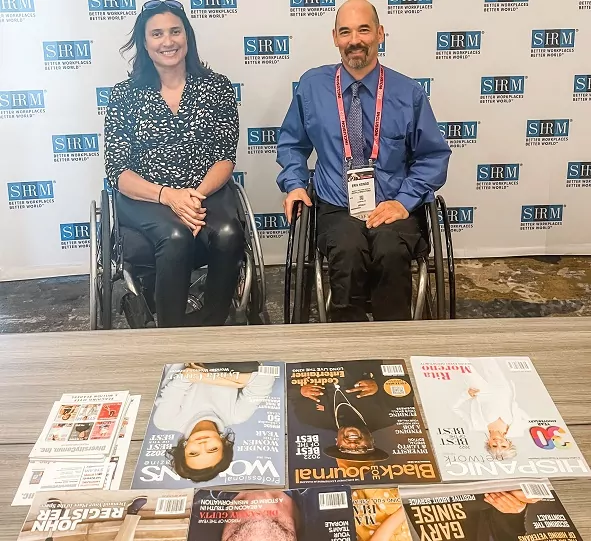By Kimberly Gladden-Eversley
After 32 years since the establishment of the American Disability Act (ADA), barriers still exist, proving that it will take more than a civil rights law to end inequity. Addressing systemic oppression towards the disabled community begins with the root of ableism. In other words, the end of prejudice against disabled people that stems from false debilitating beliefs. From the seen to the unseen, unconscious bias continues to rear its ugly head, becoming more visible to the disabled community.
From 2013 to 2021, there has been a 320% increase in ADA Title III federal lawsuits aimed at businesses that engage in performative activism. Increased accessibility takes more than a welcome sign; it takes an initial investment that the disabled community deserves. During the Society for Human Resource Management (SHRM) Diversity and Inclusion conference, we spoke with disability advocates, Tricia Downing and Erik Kondo. Both are forces to be reckoned with, challenging how the world sees them and discovering innovative ways to raise awareness.
Downing, a paralympic athlete and disability inclusion champion, fearlessly addressed the elephant in the room. “I think it comes down to educating yourself to understanding that disability is not the equivalent of defect,” she said. “Disability is a human condition, it’s part of human life and probably five people who walk by us right now have a disability that we don’t know about.”
According to the Center for Disease Control (CDC), 26% of adults in the United States have a disability and more than 10% are invisible. Sadly, adults with visible impairments are more likely to face biased judgment, causing fear for businesses and the visibly impaired.
“So, there’s fear for the person with a disability, fear of feeling like you’re not wanted, not invited, like what are they going to do, and then there’s fear on behalf of the business as to what does this mean for us?” said Erik Kondo, founder of Red Pill Innovation, home to adaptive mobility to provide affordable ways for people with physical disabilities to experience the “joy of movement.”
“When you look at us, you all of a sudden think, ‘oh wow, that person looks expensive because I’m going to have to put in a ramp and I’m going to have to put in that elevator…’” added Downing.
Talent acquisition is used to identify talent to enhance business performance and improve the likelihood of success. In most cases, it takes skill to attract the right talent, but it takes more than skill to recognize it. Investing in talent can only happen when the value is seen—a continuous challenge that Kondo breaks down using his strawberry analogy.
“Strawberries, they’re not all symmetrical; they’re kind of a little weird looking, but it doesn’t matter; they’re all yummy because that’s what you expect,” he said. “So, imagine if people were looked at that way, it wouldn’t be so strange when someone’s not exactly typical. And that’s what we’re trying to go in for, that you don’t throw them away.”
Kondo leads by example, leaving no room for disability bias to grow. If you thought mobility was an issue, think again! He can skateboard, longboard, snowboard and scooter board with mobility devices—an earned skill since becoming a wheelchair user at the age of 19. Several witnesses of his high-level performance stepped away with renewed perspective, learning that perseverance conquers all.
“You will pay for talent if you see it, but what if you don’t think there’s talent?” said Kondo as he addressed society’s low expectations often pinned upon disabled people. Unfortunately, this misconception influences hiring efforts while creating career stagnation within a community of exceptional talent.
As Downing and Kondo continue to surpass limiting beliefs, members of the disability community need equal opportunities to show their capabilities. Internships and active recruiting through the disability services department are promising ways to open doors. “I was in a specific program that allowed me to get that access and in the door to where somebody said, ‘I vouch for this person, she’s capable of doing this job.’” said Downing. “If it’s a visual disability, if the visibility that we think is a liability…are we still looking at those students and saying, ‘these are still people, they still have…goals. They’ve still…striven, strive, strove to get an education.’”
Both Downing and Kondo say that in addition to rising above stigmas by providing a helping hand, it also takes individual effort to banish unconscious bias, starting with us. “So, part of trying to solve the unconscious bias in other people is looking at yourself,” said Kondo. “The insight of knowing why you do it…will help you understand why other people do it. The things that cause you to change are likely things that will cause other people to change, too.”
Joining the fight for inclusion to create a world that is more accessible for everyone now. Institutionalized and interpersonal ableism weakens our ability to grow as a society because there is power in unity. To unite, let’s start with building connections. You can connect with Tricia Downing on LinkedIn or her personal account at triciadowning.com, and Eric Kondo can be reached on LinkedIn and at redpillinnovations.com.



